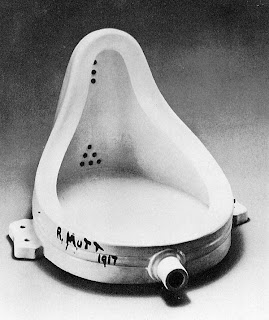Inside the museum there are six floors of which the 2nd, 3rd, and 4th are actual galleries. The elevator has a soundtrack of a man repeating a speech and certain words which reminded me of some of the videos we had seen in class where repetition was a common theme, such as Clown Torture.
The exhibits change every couple of months and at the time that I went, the exhibit on the 2nd floor was titled "Free" and the thirs anf fourth floors were an exhibit called "The Last Newspaper". This was supposed to relate to the fact that the use of newspaper in fine art is no longer a novelty. All of the exhbits on these floors had to do with the nespaper and the press, incorporating it into the art by using it or re-imaging it in one's own drawings or sculptures.
Some of the exhibits that stuck out to me were the large round, blue carpet (because I everybody was walking around it and all I wanted to do was lay down in the middle of it), the mannequin women with dresses which portrayed pictures of topics commonly brought up in the news (because, as a Sociology major, I took a sociological perspective of how we relay news to people and how it effect a society's views to favor or go against a certain issue and because they only know what is revealed through the media when there are many other things that are kept covered up - one of the dresses portrayed images to represent this idea), the typewriter that typed by itself and produced a large scroll of paper which gathered all around it on the floor (It was crowded with people around it so I wasn't able to get close enough to know what it was typing), and the projector showing images of what would be a sunset and a person holding a picture of a sunset over the original image. This last exhbit was part of "Free" and was titled "The Sun Is Always Setting Somewhere Else". I particularly enjoyed that one because I am a collector of beach images. My bedroom is a beach theme and I have alot of photography and art of beaches, sunsets, and the ocean around my room.
































